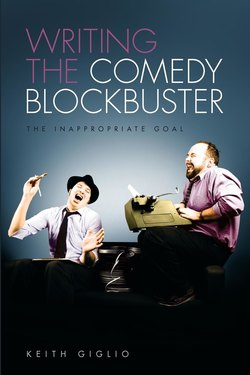Читать книгу Writing the Comedy Blockbuster - Keith Giglio - Страница 9
На сайте Литреса книга снята с продажи.
ОглавлениеPART ONE
HOW TO THIS BOOK
I admit that the idea of writing a chapter on how to use this book seems odd.
Especially to me, and I am writing it.
When my wonderful editor proposed this idea, I thought: Don’t you just read the book, and do what the book says to do? But then I thought about you — in the bookstore, on your commute, in the bathroom (hold on — backspace, delete that image) — and your comedy blockbuster dreams.
Did you ever order something that came in a box? With lots of screws? And parts? And press-wood? With instructions on how to put it together? Well, think of this book as everything in the box. It’s time we put it together.
TOOLS NEEDED FOR THIS BOOK (NOT INCLUDED)
Blank notebook, pencil or pen, index cards, markers, a word processor on a computer, your imagination, and your sense of humor are all you need!
You should also have a secret desire to make people laugh, make a lot of money, and induce massive regret for those who would not date you in high school. As for those unenlightened few (or, in my case, many) who scorned you in high school, we are not going to throw this book at them. It’s a trade paperback not a hardback, so it would not cause that much damage — except maybe an angry ouch. And also, it’s wrong.
Please only use this book for the power of good, not evil. You are going to use it to write that great screenplay, that comedy blockbuster. That is the best instrument of revenge.
Wait, so that’s why people write comedy — for revenge? No, not at all, but chances are, if you are like me, you developed a sense of humor as a defense mechanism. I was a skinny kid with a big nose living on Staten Island with a significant number of cro-magnons. You know how you keep the cro-magnons from beating you up? Make them laugh. And then run really fast.
This book will teach you how to use that sense of humor to make some dollars and cents — that is, how to write a comedy blockbuster.
The best way to use this book is to... hold on to your hat here… read it. From beginning to end. Read the book. Wow. You need a chapter to tell me this? Yes, I want you to read the book and absorb the material on the first read.
There are three main parts of this book. In the first part, you read about the history of film comedy and the various subgenres. As you read about the movies, target some of the movies you find funny. During this section you should start getting an idea of the comedies you like to watch; or, more specifically, the kind you wish you had written. The keys here are “getting an idea.” Good ideas take time. They’re like seeds. You have to plant them, water them, let ’em grow. Ever bite into a popcorn kernel that hadn’t popped? It tastes terrible and hurts your teeth. Comedy ideas that are not fully realized are unpopped kernels. You need to let them sit there a while until they pop. While you are reading about the great history of film comedies, watch some great film comedies. So while READING the first part of the book, you should WATCH these movies.
The second part of the book — and the main idea behind it — is the exploration of the inappropriate goal and specifically what goes into the writing of a comedy blockbuster.
IF YOU ARE A STARTING A COMEDY SCREENPLAY…
Start from the beginning. Open a computer file. Read each chapter. Do the exercises and develop your “scriptment” as we move along. Think of this book like a video game — don’t go to the next level until you have completed each one.
IF YOUR HAVE ALREADY WRITTEN A SCREENPLAY AND ARE STUCK IN DEVELOPMENT HELL.
If you’re smart enough to get stuck in development hell, good for you. There are worse places in hell to be. But you do want to get out of there and it’s very hard to climb out of hell with the weight of studio notes. Use this book as a roadmap.
Also, if you are using this book for academic purposes, assign one chapter a week, screen the films mentioned in that chapter, and enjoy a dirty martini with the attractive co-ed of your gender-specific choice.
This book was developed as an academic course at the Writer’s Program at UCLA. It is structured the same way I have structured my classes. Each chapter is a lecture and a lesson. Have the students do the work and the exercises.
Mostly, to all writers — I encourage you to be fearless, to push the envelope, to teach us to laugh at ourselves and see ourselves for the fools we all are — every day of our lives as we chase our own inappropriate goals.
